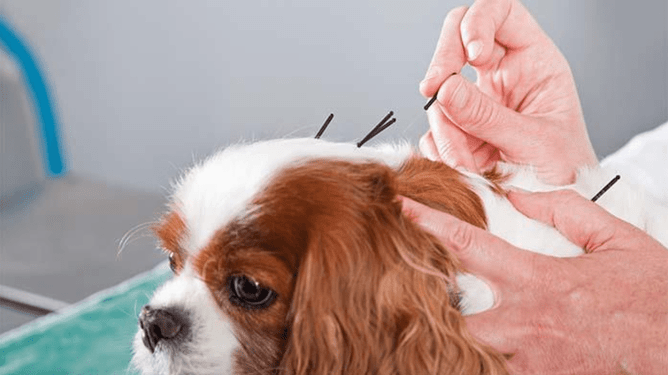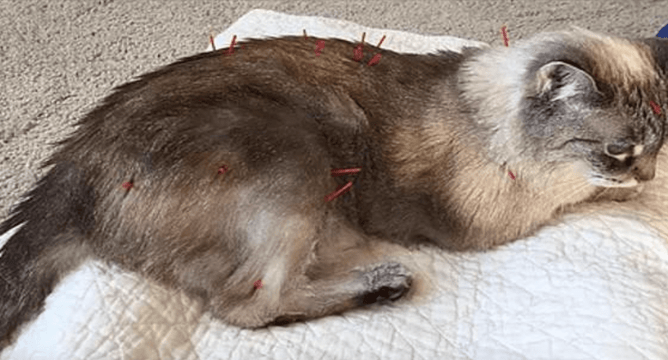Acupuncture is becoming an increasingly popular modality for pain management in veterinary medicine (1). Acupuncture involves the insertion of very fine needles into acupuncture points on the skin to restore balance, relieve pain and encourage the body to heal.
Acupuncture’s roots date back approximately 3000 years ago to Traditional Chinese Medicine (TCM) where the philosophy of acupuncture centres on an energy source termed, “Qi”. Illness is believed to occur when there is an interruption to the flow of Qi along specific channels (termed “meridians”), and the insertion of acupuncture needles restores balance and improves energy flow (2). Western medical acupuncture is an adaptation of TCM, where the focus in not exclusively on “Qi” but rather is based on our current knowledge of human anatomy, physiology and pathology supported by evidence-based literature (3). Scientific research has confirmed that needle penetration through the skin, whether at acupuncture points or not, has physiological effects (3). These will be discussed below.
How does Acupuncture work?
Acupuncture involves the stimulation of specific acupuncture points which leads to localised micro-trauma within the tissue the needle penetrates. These acupoints are considered 'neurovascular bundles', a concentrated area of free nerve endings, small arterioles, venioles, lymphatics and mast cells (4).
Stimulation of acupuncture points causes activation of the body’s nervous system and leads to the following neurophysiologic responses:
The release of endogenous opioids to provide analgesia (7)
Modulating of the brain’s perception of pain (via the limbic centre) (3)
Signalling release of cortisol – a hormone with anti-inflammatory properties (8)
Stimulation of the immune system
Reducing inflammation within the body
Increasing blood flow to the acupuncture points being treated (7,8)
Conditions commonly treated in Animals
There are a number of conditions for which acupuncture has been found effective for, and thus integrated into veterinary medicine. We will briefly discuss each below:
Pain management:
Acupuncture can be very effective in treating chronic and significant pain-producing conditions. Cancer is one of the leading causes of mortality in people as well as companion animals (9). Acupuncture has been found to reduce pain and promote quality of life (9); as well as reduce drug-associated side-effects such as nausea, vomiting and fatigue in cancer patients (10).
Musculoskeletal conditions:
Acupuncture is commonly used in the management of osteoarthritis in people, and has been transferred for use in animals in particular for musculoskeletal conditions such as hip and elbow dysplasia, medial shoulder instability, biceps tendinopathy, and muscle, tendon and ligament injuries. The segmental effects of acupuncture can provide analgesia, improve circulation, and increase mobilisation (1). A retrospective study of senior dogs with cranial cruciate ligament rupture found those treated with acupuncture recovered stifle function within 6 to 10 months of initiating treatment, and did not require surgery (11). In addition, there have been a number of clinical trials demonstrating the effectiveness of acupuncture in dogs with hip dysplasia (12). One study found that of 13 cases treated with electroacupuncture, eight had complete resolution of clinical signs of hip pain and disability, with the remaining showing good or fair improvement (13).
Neurological conditions:
Acupuncture has been used to treat spinal conditions, including intervertebral disc disease in dogs, spinal cord injury, facial and limb paralysis (1). Acupuncture can assist with nerve regeneration, and may be effective in the treatment of brachial plexus injuries (1). Acupuncture, particularly electroacupuncture, has been shown to improve analgesia and accelerate recovery of motor functions in dogs with intervertebral disc disease (IVDD) (14). Another study in dogs with thoracolumbar IVDD found dogs who received electroacupuncture returned to walking in a shorter timeframe and with less assistance than dogs that did not receive acupuncture (15).
Dermatological Conditions:
Clinical trials for the use of acupuncture to treat a variety of canine dermatological conditions have been investigated. At this point, there are promising results of acupuncture’s efficacy in treating atopic dermatitis, herpes zoster pain, and overwhelming evidence to support its effectiveness in wound healing (16).
Gastrointestinal conditions:
Acupuncture has been found to regulate gastric motility, gastric secretions, hormones and metabolism. Scientific research has demonstrated its effectiveness for treating gastrointestinaI conditions such as vomiting, diarrhea and constipation. Due to its effects on the gastrointestinal system, acupuncture may be beneficial for gastrointestinal pain and inflammation, pancreatitis, tenesmus, rectal prolapse and gastrointestinal disease (17).
What can I expect during the acupuncture session?
At your animal's first appointment a detailed history of the injury, surgery and related concerns will be taken. A thorough assessment of the areas of the body related to the injured site, or any contributing to this condition, will be completed. In almost all cases an individualised treatment plan will be developed for your animal. If you have relevant veterinary diagnostic results or imaging reports, please bring these along with you. Please allow up to 60 minutes for this consultation.
During the acupuncture session all measures will be taken to provide a quiet, relaxed and comfortable environment for your animal. We will provide comfortable bedding and blankets, but encourage you to bring your pet's favourite comfort blanket or toy, as well as favourite foods. We do provide natural dried foods as treats for acupuncture sessions but advise you bring your own if your animal has food allergies or particular food preferences. Once inserted the acupuncture needles will typically remain insitu for 10 - 20 minutes.
Will acupuncture cause discomfort for my animal?
Acupuncture needles are very fine. It is common for your animal to feel a small prick as the needle passes through skin. A slight tingle or numbness can be felt once the needle is insitu - this is referred to as De Qi, a sign that the acupuncture point has been stimulated. Your animal may show signs of awareness of this sensation by turning to look at the area, moving the body part somewhat or trying to lick the area. In most cases however, animals quickly relax after the initial needle sensation ceases.
How many treatments are required?
A treatment protocol will be outlined in your animal's initial acupuncture consultation. This will usually involve one to three sessions per week for several weeks, depending on the condition being treated. The number of treatment sessions will taper off as your animal improves. Acupuncture has a cumulative effect, hence repeated treatments are required. That said, the overall aim is to achieve the greatest degree of improvement in pain, function and mobility, and to maintain that level with the least number of treatments required. Acupuncture treatments are approximately 30 minutes in duration. Needles are inserted 10-20 minutes for best effect, and between 4-6 acupuncture treatments are recommended for clinical practice (5). Improvement is usually noted within 1 - 3 days following acupuncture treatment.
What are the potential risks associated with Acupuncture?
Acupuncture is a safe, non-invasive treatment that is usually very well tolerated in animals. Bruising or minor bleeding may occur after removal of a needle, but this is rare. Single-use, disposable sterile needles are used for acupuncture treatment, therefore, infection is uncommon. Some animals may appear a little sore, stiff or tired following acupuncture but these symptoms are transient and usually resolve within 24 - 48 hours.
Acupuncture is contraindicated for animals with localised inflammed or infected skin, bleeding disorders, immunosuppression, haemodynamic shock, and at acupuncture points which may cause premature labour in pregnant animals (6).
Aftercare following Acupuncture
It is recommended that your animal has access to water and food following their acupuncture treatment, as acupuncture may affect blood sugar levels. It is common for animals to show signs of tiredness following their treatment session. For this reason, they should be allowed to rest with no scheduled walks, training or exercise for the remainder of that day.
References
1. Dewey, C.W., and Xie, H. (2021). 'The scientific basis of acupuncture for veterinary pain management: A review based on relevant literature from the last two decades', Open Veterinary Journal, 11 (2), pp. 203-209.
2. Zijlstra, F.J., van den Berg-de Lange, I., Huygen, F.J, and Klein, J. (2003) 'Anti-inflammatory actions of acupuncture', Mediators of Inflammation, 12(2), pp. 59-69.
3. White, A. (2009). Western medical acupuncture: a definition. Acupuncture in Medicine, 27, 33-35.
4. Gong, C., and Liu, W. (2019) 'Advanced research validates classical principles-the neurobiological mechanisms involved in acupuncture for pain management', Longhua Chinese Medicine, 2, 16.
5. Lindley, S., Cummings, T. M., Cummings, T. M., & Lindley, S. (2006). Essentials of western veterinary acupuncture. Ames IA: Blackwell Pub..
6. Xie, H., and Preast, V. (2007) Xie’s Veterinary Acupuncture. Blackwell Publishing: Ames, IA, USA, 2007.
7. Zhang, R., Lao, L., Ren, K. and Berman, B.M. (2014) 'Mechanisms of acupuncture-electroacupuncture on persistent pain', Anesthesiology, 120, pp. 482–503.
8. McDonald, J.L., Cripps, A.W. and Smith, P.K. (2015) 'Mediators, receptors, and signalling pathways in the anti- inflammatory and antihyperalgesic effects of acupuncture', Evidence Based Complementary and Alternative Medicine, 975632.
9. Xie, H., Hershey, B., and Ma, A. (2017) ‘Review of evidence-based clinical and experimental research on the use of acupuncture and Chinese herbal medicine for the treatment or adjunct treatment of cancer’, American Journal of Traditional Chinese Veterinary Medicine, 12(1), pp. 69-77.
10. Romsland, T., and Shiau, D. S. (2020). ‘Traditional Chinese Medicine Interventions for Managing Cancer Treatment Induced Side Effects in Human Patients: A Systematic Review and Meta-Analysis with Comments on Veterinary Medicine’, American Journal of Traditional Chinese Veterinary Medicine, pp. 31-38.
11. Lee, L. (2019) ‘Non-Surgical Treatment for Cranial Cruciate Ligament Rupture in Senior Dogs: A Retrospective Case Series’, American Journal of Traditional Chinese Veterinary Medicine, 14, pp. 49–64.
12. Jaeger, G.T., Larsen, S., Søli, N., and Moe, L. (2006) ‘Double blind, placebo-controlled trial of the pain- relieving effects of the implantation of gold beads into dogs with hip dysplasia’, Veterinary Record, 158, pp. 722–726.
13. Gülanber, E. G. (2008). ‘The clinical effectiveness and application of veterinary acupuncture’, American Journal of Traditional Chinese Veterinary Medicine, 3(1), pp. 9-22.
14. Roynard, P., Lauren, F., Xie, H., and Fowler, M. (2018) ‘Acupuncture for Small Animal Neurologic Disorders’, Veterinary Clinics: Small Animal Practice, 48, pp. 201–219.
15. Hayashi, A.M., Matera, J.M., and de Campos Fonseca Pinto, A.C. (2007) ‘Evaluation of electroacupuncture treatment for thoracolumbar intervertebral disk disease in dogs’, Journal of the American Veterinary Medical Association, 231, pp. 913–918.
16. van den Berg-Wolf, M., and Burgoon, T. (2017) ‘Acupuncture and Cutaneous Medicine: Is It Effective?' Medical Acupuncture, 29(5), pp. 269-275.
17. Dill, S., and Bierman, N. (2001) Acupuncture for gastrointestinal disorders. In: Schoen, A., 2nd ed. Veterinary Acupuncture, Ancient Art to Modern Medicine. Mosby, St Louis, MO., pp. 239–260.




